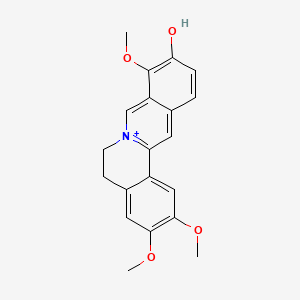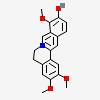Dehydrocorydalmine
PubChem CID
3083983
Molecular Formula
Synonyms
- Dehydrocorydalmine
- 6877-27-6
- CHEBI:70645
- 2,3,9-trimethoxy-5,6-dihydroisoquinolino[2,1-b]isoquinolin-7-ium-10-ol
- Dibenzo(a,g)quinolizinium, 5,6-dihydro-10-hydroxy-2,3,9-trimethoxy-
Molecular Weight
338.4 g/mol
Computed by PubChem 2.2 (PubChem release 2021.10.14)
Dates
- Create:2005-08-09
- Modify:2025-01-18
Description
Dehydrocorydalmine is an alkaloid. It has a role as a metabolite.
Dehydrocorydalmine has been reported in Fibraurea chloroleuca, Stephania yunnanensis, and other organisms with data available.
Chemical Structure Depiction

2,3,9-trimethoxy-5,6-dihydroisoquinolino[2,1-b]isoquinolin-7-ium-10-ol
Computed by Lexichem TK 2.7.0 (PubChem release 2021.10.14)
InChI=1S/C20H19NO4/c1-23-18-9-13-6-7-21-11-15-12(4-5-17(22)20(15)25-3)8-16(21)14(13)10-19(18)24-2/h4-5,8-11H,6-7H2,1-3H3/p+1
Computed by InChI 1.0.6 (PubChem release 2021.10.14)
VQSYXVWEZATIHL-UHFFFAOYSA-O
Computed by InChI 1.0.6 (PubChem release 2021.10.14)
COC1=C(C=C2C(=C1)CC[N+]3=C2C=C4C=CC(=C(C4=C3)OC)O)OC
Computed by OEChem 2.3.0 (PubChem release 2024.12.12)
C20H20NO4+
Computed by PubChem 2.2 (PubChem release 2021.10.14)
6877-27-6
dehydrocorydalmine
Property Name
Property Value
Reference
Property Name
Molecular Weight
Property Value
338.4 g/mol
Reference
Computed by PubChem 2.2 (PubChem release 2021.10.14)
Property Name
XLogP3-AA
Property Value
3.4
Reference
Computed by XLogP3 3.0 (PubChem release 2021.10.14)
Property Name
Hydrogen Bond Donor Count
Property Value
1
Reference
Computed by Cactvs 3.4.8.18 (PubChem release 2021.10.14)
Property Name
Hydrogen Bond Acceptor Count
Property Value
4
Reference
Computed by Cactvs 3.4.8.18 (PubChem release 2021.10.14)
Property Name
Rotatable Bond Count
Property Value
3
Reference
Computed by Cactvs 3.4.8.18 (PubChem release 2021.10.14)
Property Name
Exact Mass
Property Value
338.13923312 Da
Reference
Computed by PubChem 2.2 (PubChem release 2021.10.14)
Property Name
Monoisotopic Mass
Property Value
338.13923312 Da
Reference
Computed by PubChem 2.2 (PubChem release 2021.10.14)
Property Name
Topological Polar Surface Area
Property Value
51.8 Ų
Reference
Computed by Cactvs 3.4.8.18 (PubChem release 2021.10.14)
Property Name
Heavy Atom Count
Property Value
25
Reference
Computed by PubChem
Property Name
Formal Charge
Property Value
1
Reference
Computed by PubChem
Property Name
Complexity
Property Value
461
Reference
Computed by Cactvs 3.4.8.18 (PubChem release 2021.10.14)
Property Name
Isotope Atom Count
Property Value
0
Reference
Computed by PubChem
Property Name
Defined Atom Stereocenter Count
Property Value
0
Reference
Computed by PubChem
Property Name
Undefined Atom Stereocenter Count
Property Value
0
Reference
Computed by PubChem
Property Name
Defined Bond Stereocenter Count
Property Value
0
Reference
Computed by PubChem
Property Name
Undefined Bond Stereocenter Count
Property Value
0
Reference
Computed by PubChem
Property Name
Covalently-Bonded Unit Count
Property Value
1
Reference
Computed by PubChem
Property Name
Compound Is Canonicalized
Property Value
Yes
Reference
Computed by PubChem (release 2021.10.14)
Follow these links to do a live 2D search or do a live 3D search for this compound, sorted by annotation score. This section is deprecated (see here for details), but these live search links provide equivalent functionality to the table that was previously shown here.
Same Parent, Exact Count
Mixtures, Components, and Neutralized Forms Count
Similar Compounds (2D)
Similar Conformers (3D)
Patents are available for this chemical structure:
https://patentscope.wipo.int/search/en/result.jsf?inchikey=VQSYXVWEZATIHL-UHFFFAOYSA-O
The LOTUS Initiative for Open Natural Products Research: frozen dataset union wikidata (with metadata) | DOI:10.5281/zenodo.5794106
- ChEBIDehydrocorydalminehttps://www.ebi.ac.uk/chebi/searchId.do?chebiId=CHEBI:70645
- LOTUS - the natural products occurrence databaseLICENSEThe code for LOTUS is released under the GNU General Public License v3.0.https://lotus.nprod.net/Dehydrocorydalminehttps://www.wikidata.org/wiki/Q27138978LOTUS Treehttps://lotus.naturalproducts.net/
- ChEMBLLICENSEAccess to the web interface of ChEMBL is made under the EBI's Terms of Use (http://www.ebi.ac.uk/Information/termsofuse.html). The ChEMBL data is made available on a Creative Commons Attribution-Share Alike 3.0 Unported License (http://creativecommons.org/licenses/by-sa/3.0/).http://www.ebi.ac.uk/Information/termsofuse.html
- ChemIDplusChemIDplus Chemical Information Classificationhttps://pubchem.ncbi.nlm.nih.gov/source/ChemIDplus
- EPA DSSToxDibenzo(a,g)quinolizinium, 5,6-dihydro-10-hydroxy-2,3,9-trimethoxy-https://comptox.epa.gov/dashboard/DTXSID10218876CompTox Chemicals Dashboard Chemical Listshttps://comptox.epa.gov/dashboard/chemical-lists/
- KNApSAcK Species-Metabolite Database
- Natural Product Activity and Species Source (NPASS)
- Metabolomics WorkbenchDehydrocorydalmine Trifluoroacetatehttps://www.metabolomicsworkbench.org/data/StructureData.php?RegNo=123138
- WikidataDehydrocorydalminehttps://www.wikidata.org/wiki/Q27138978
- PubChem
- Medical Subject Headings (MeSH)LICENSEWorks produced by the U.S. government are not subject to copyright protection in the United States. Any such works found on National Library of Medicine (NLM) Web sites may be freely used or reproduced without permission in the U.S.https://www.nlm.nih.gov/copyright.htmldehydrocorydalminehttps://www.ncbi.nlm.nih.gov/mesh/67007233
- MolGenieMolGenie Organic Chemistry Ontologyhttps://github.com/MolGenie/ontology/
- PATENTSCOPE (WIPO)SID 474330062https://pubchem.ncbi.nlm.nih.gov/substance/474330062
CONTENTS

